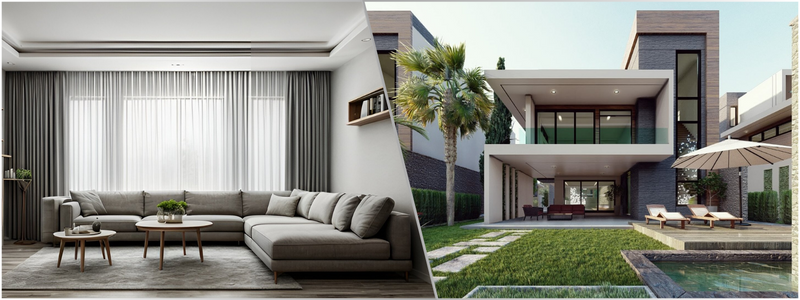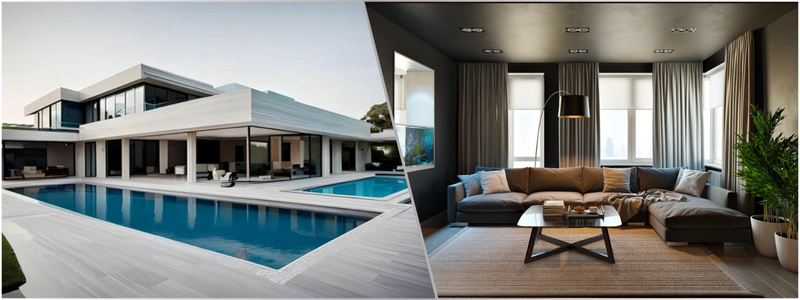The past few years have seen significant transformations and breakthroughs in the property development industry. Most of these developments were made possible thanks to the numerous technological advancements that popped up like mushrooms everywhere. One of these technological innovations is none other than 3D rendering. This emerging tool is a real game-changer as it revolutionized the process of conceptualization, design, marketing, and sales of today’s properties. This article discusses how 3D rendering firms is transforming the property development industry for companies.
A quick history of property development
Before you delve into the 3D wondering world, it is important to understand the traditional property development methods. Property development historically involved developers, architects, and investors working together on paper-based plans, physical models, and blueprints. These static representations usually left so much to the imagination. As a result, stakeholders had a hard time grasping and appreciating the true potential of a project.
RELATED: 3D modeling vs. 3D rendering services
Limitations and weaknesses of traditional property development methods
The conventional methods of property development had a few notable limitations, including the following:
High costs
Creating a physical model used to be too time-consuming and often required various and significant revisions.
Absence of realism
Physical models and 2D drawings cannot convey the depth and realism of a property that can be easily portrayed using 3D real estate rendering services in real estate and other property development industries.
Limited collaborations
Stakeholders relied a lot on their capacity to interpret plans, which often resulted in gaps in communication and misunderstandings.
Marketing concerns
Marketers encountered challenges in presenting properties to prospective buyers using static visuals.
Slower decision-making
The required time for approvals and revisions often resulted in the delay of project timelines.
RELATED: Integrating 3D rendering with photography for architectural development companies
Benefits of 3D rendering for real estate and property development
3D rendering technology made a pivotal change in the property development industry. It has introduced highly realistic, interactive, and dynamic visualizations that remarkably improved conceptualizing, designing, marketing, and selling properties. Here are some of the ways that 3D rendering benefits the property development industry:
Cost-effective solution for design errors
Ask any 3D architectural rendering company, and they will surely tell you that mistakes and errors are bound to happen during the initial phases of the project. Addressing these initial errors can consume a lot of resources and take too much time.
The good news is that 3D rendering has substantially sped up the entire process and allowed changes and adjustments without spending significant cash on testing physical prototypes or numerous mock-up designs to see and check flaws. Thanks to digital rendering tools, making adjustments and changes is now faster and easier. It means that there is a lesser need for major reworks during the building process.
RELATED: Lighting adjustments in 3D renders: essential tips for companies and services

With the help of this economical method, the developers can precisely and quickly adjust their ideas. It notably reduces the risk of expensive changes being carried out throughout the building phase.As a result, the overall success and efficiency of the project are further improved by saving significant financial resources and time.
More immersive experiences and advanced visuals
3D architectural visualization services, with its transformative power, has become a critical aspect of the property development industry by giving an enhanced visualization and a sneak peek of the future of the project. Unlike traditional 2D drawings, which often result in ambiguity, 3D rendering technology offers endless three-dimensional choices. Using 3D rendering in real estate and property development allows companies to provide a visual walkthrough and breathe life into architectural plans even before the actual construction.
It gives a more realistic representation that architects, developers, and potential investors can view easily. The mix of the small details, the sense of scale, and the way shadow and light play make for an amazing visual experience. The materials and their lifelike representation can also offer an initial estimate of the maintenance expenses of the property.
RELATED: How photorealistic 3D rendering design saves companies money
However, aesthetics is not the only beautiful thing about this enhanced visualization, as it also permeates the different facets and aspects of the project. 3d photorealistic rendering professionals can also help streamline decision-making, from layout optimizations to meticulous tweaks in design. It is like a guiding star that smoothes down the entire development process and increases confidence at each step of the way.
Next-level property marketing
One essential aspect of property development is effective marketing, particularly as far as its success is concerned. Aside from offering 3D constructions, 3D rendering can also help property developers in terms of advertising and marketing. Realistic 3D designs function as indispensable marketing tools that developers can use to come up with visually enticing promotional materials.
The designs can be used in websites, presentations, and brochures, allowing developers to present the true-to-life appearance of the project upon its completion. The skill can enhance marketing efforts by gaining more attention and speeding up the sales process.
RELATED: How to create a virtual tour of homes with 3D rendering services
Offers realism
Visualizing property designs from traditional 2D drawings alone can be challenging because they inherently lack realism. One of the most significant advantages of 3D rendering is that it includes light as among its primary components and combines different building materials and textures. The combination can produce a realistic image of the project’s appearance once completed, even before laying out a single brick.
What sets these 3D renders apart from the rest is the outstanding quality they can offer. The level of precision and detail is extremely remarkable, and they are almost impossible to distinguish from high-resolution photographs. They help bridge the gap between reality and conceptual design with exemplary realism.
More seamless communication
Collaboration is critical in the property development industry. It is where 3D rendering becomes an essential tool for effective and clear communication. Effective communication serves as the cornerstone for a development company to succeed and 3D visualization services are a tool that plays a key role here. The well-made 3D visualizations act as the foundation for communication and encourage a shared understanding of allowing in-depth discussions.

RELATED: The different types of CG visuals a 3D rendering service can make
The 3D rendering technology leaves little room for uncertainties. It allows builders, architects, stakeholders, and developmental experts to communicate highly precisely and effectively. These visualizations also make communicating and showcasing meticulous design adjustments and complicated architectural details easier. Ultimately, this kind of alignment improves the success and efficiency of the project by lessening the chances of misinterpretations and misunderstandings.
Permit acquisition made easy
Most property developers often get lost in a pile of documents once it’s time to acquire permits. It can result in a substantially slower financing acquisition. Getting the correct financing for a property is among the most challenging facets of the development cycle. Even financiers experience difficulty making sense of technical reports filled with jargon. It is where 3D rendering enters the picture. This technology can speed up the whole process by avoiding misunderstandings and presenting a clear intent of the design of the property.
With the help of 3D rendering designers developers can effectively convey their ideas to property associations, authorities, and other stakeholders by coming up with visually appealing and well-thought-out project proposals. Well-constructed visual proposals and clear presentation usually result in faster permit and approval acquisition, speeding up the development process timeline.
RELATED: How 3D rendering services are used by architects for each stage of a new project
Applications of 3D rendering in the real world
Here are two real-world case studies to give you an idea of 3D rendering and its impact on property development:
Adaptive reuse and historical preservation
3D rendering plays a critical role in adaptive reuse and historic preservation projects. Think of a historic landmark that requires repurposing and renovation. 3D renderings can help recreate the structure to its former glory and, at the same time, show how it will transform into a functional modern space. These 3D renderings can also help preservationists secure support and funding by clearly defining the project’s potential. They guide builders and architects in their efforts to retain historical accuracy while adding modern amenities.
Pre-construction visualization
Think of a developer who is planning a luxury condo complex right in the heart of a prime urban area. Conventional methods require architectural design experts to create models and blueprints that can only convey limited details. 3D rendering, on the other hand, can allow the creation of photorealistic animations and images that represent the entire development.
RELATED: Architectural 3D rendering styles and visualization techniques
Potential buyers can go on virtual tours around the condo units, appreciate the picturesque views of the penthouse, and look at the meticulously designed common spaces. This sheer level of realism and detail makes it easier for prospective buyers to make educated decisions. Most importantly, it also usually results in faster sales.
3D rendering and its future in property development
With the continuous evolution of technology, how 3D rendering transforms the property development industry will continue to become more widespread soon. Some possibilities and key trends that can be expected soon include AI-enhanced rendering, augmented reality integration, real-time rendering, and sustainable visualization.
How Cad Crowd can help
3D rendering has undoubtedly revolutionized the property development industry by offering immersive and realistic experiences during the whole development lifecycle. Cad Crowd is here to help you find the best 3D rendering artists who can help you in your property development process.
